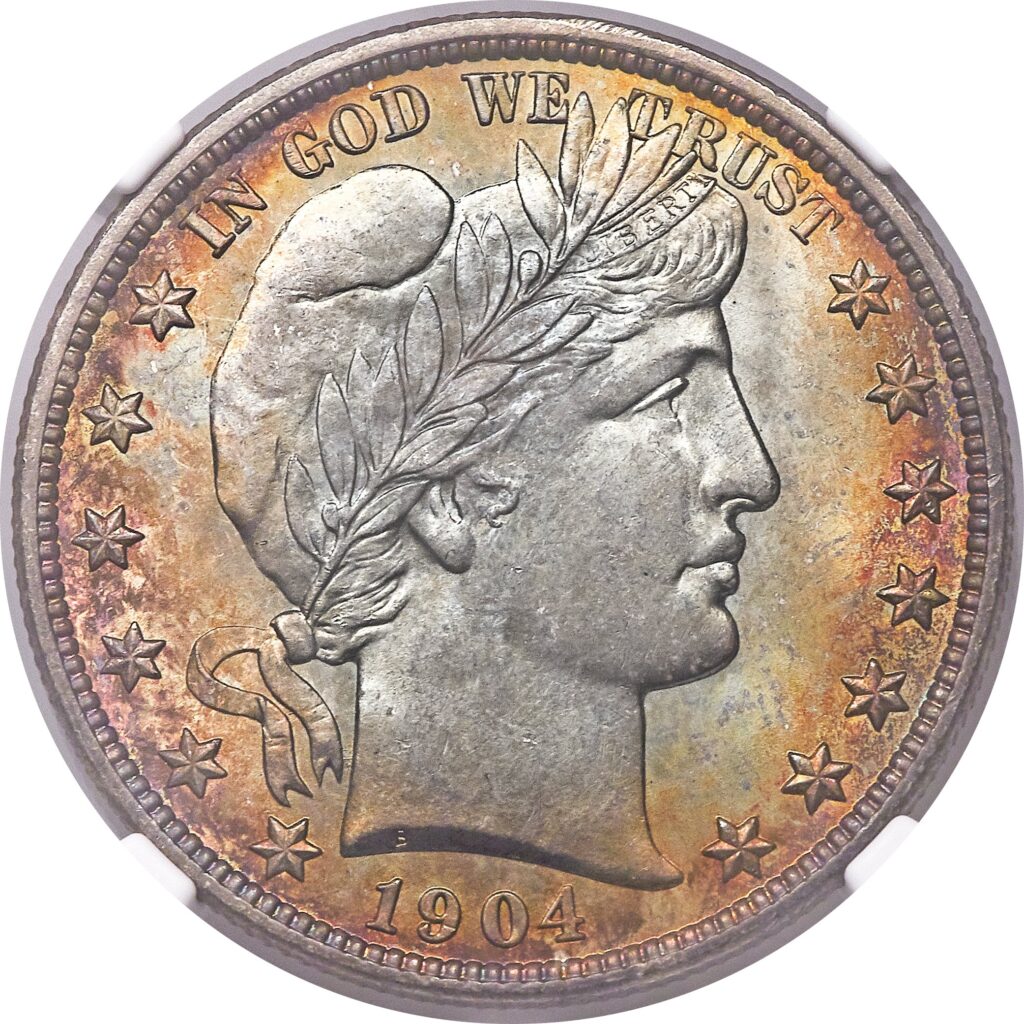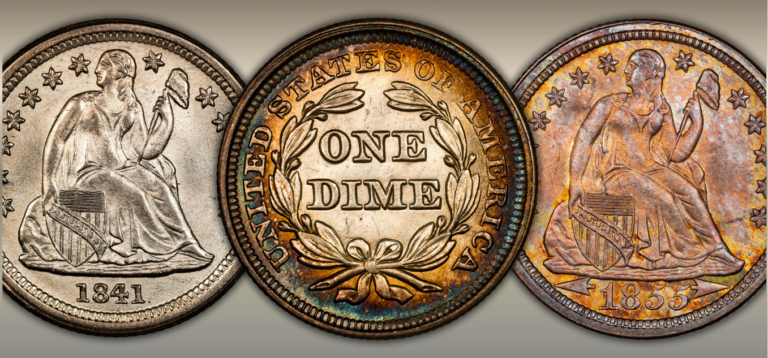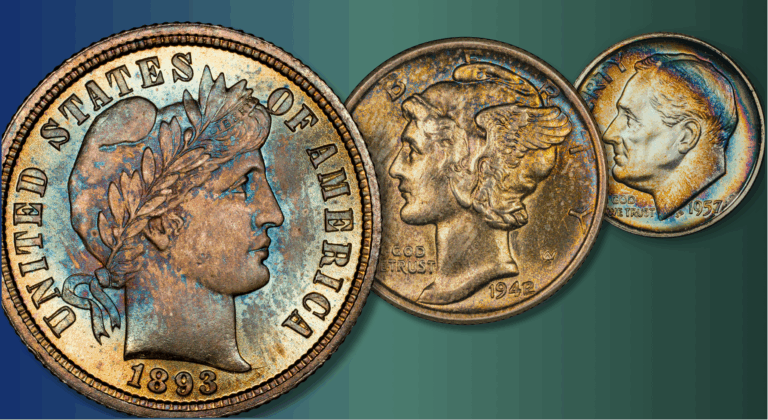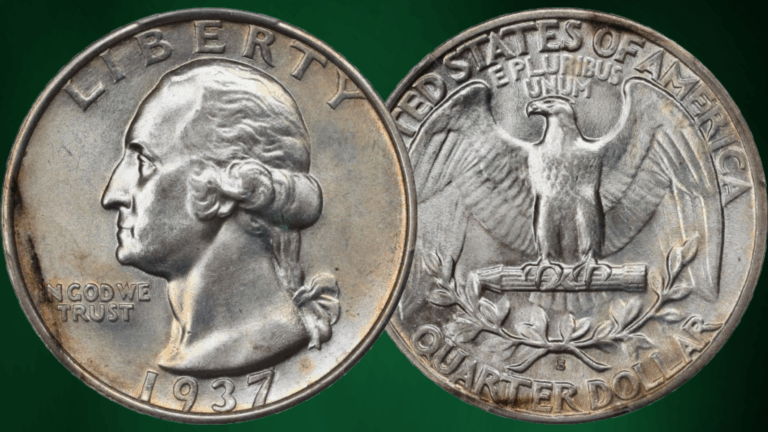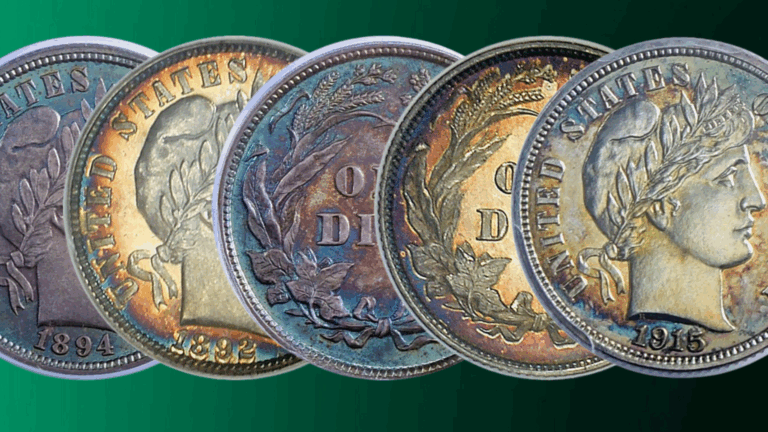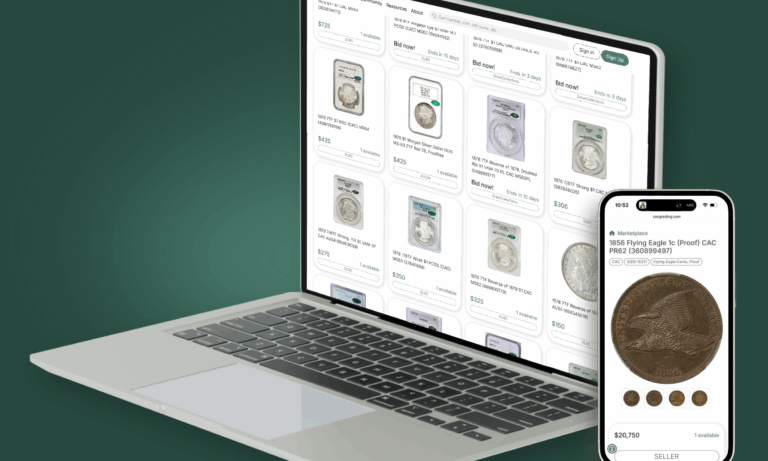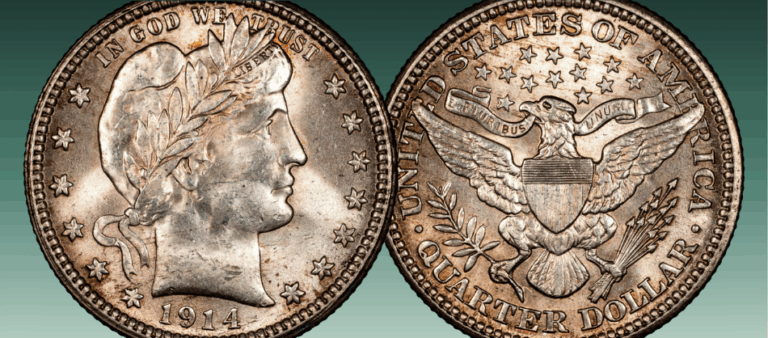by Greg Reynolds
Barber half dollars were minted from 1892 to 1915. They are very similar in design to Barber quarters, which were minted from 1892 to 1916. Barber halves are not rare, and it is rational to expect to be able to acquire representatives of all dates in the series. A set of relatively original and attractive, Extremely Fine (‘XF’)-40 to Almost Uncirculated (AU)-58 grade coins ‘by date,’ is not easy to build, though is a very realistic objective.
Most Barber halves circulated to a great extent. Until the 1950s, half dollars were extremely popular among the general public. A very large percentage of Barber halves circulated to the point that they now grade below VF-20 or were melted in an earlier era. Indeed, the vast majority of surviving Barber halves, of all dates, grade from AG-03 to Fine-15, with most grading in the range from Good-04 to VG-08.
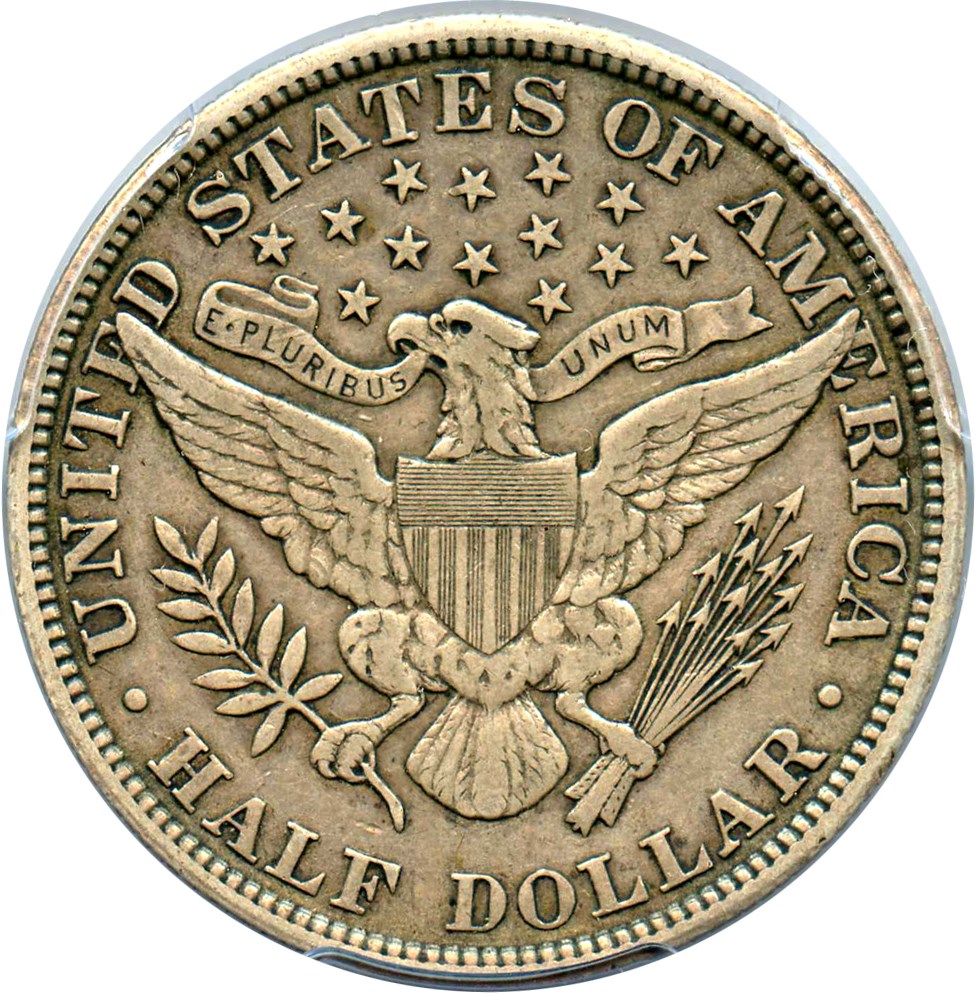
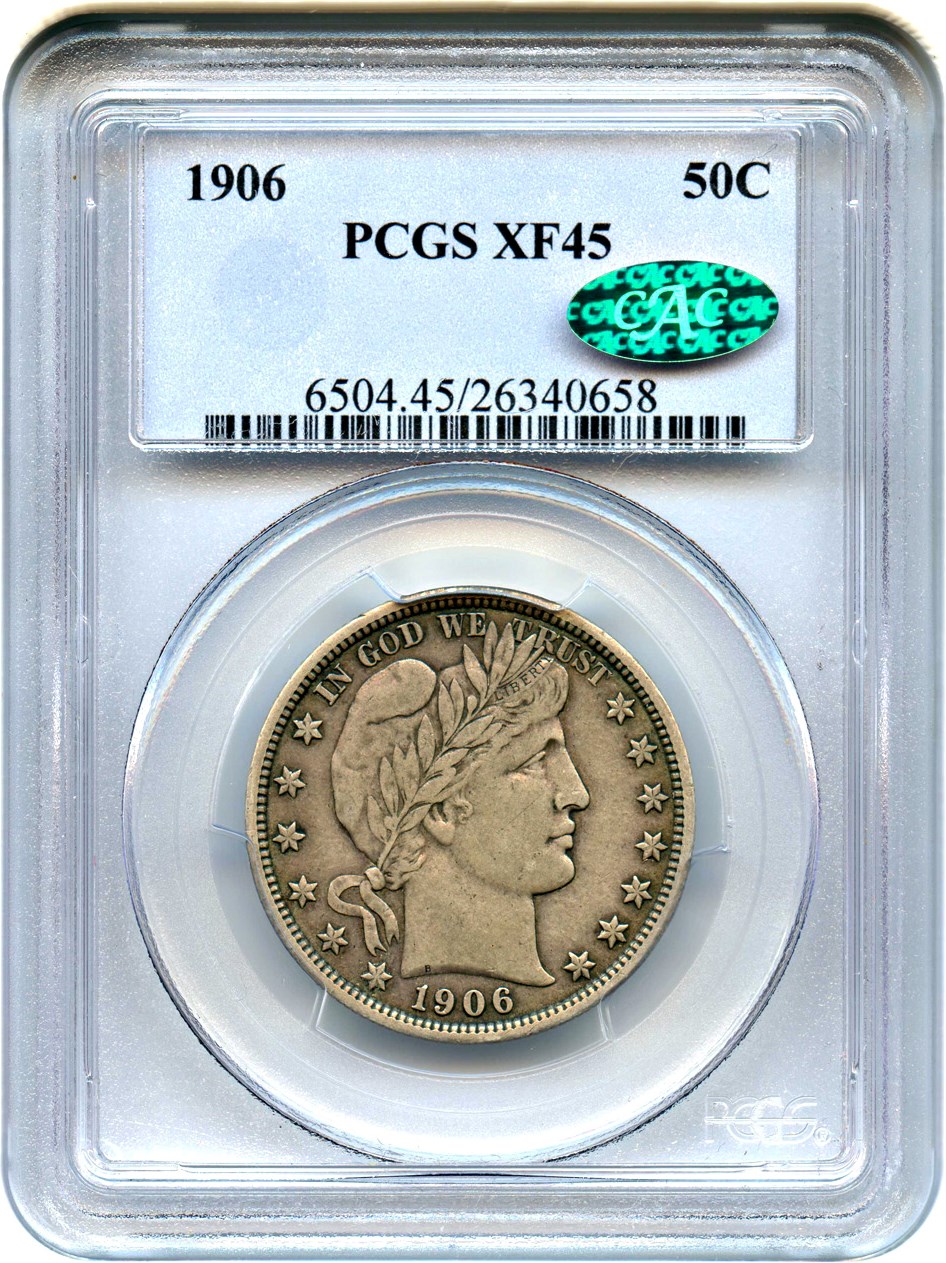
When I was a kid, I collected some Good to Very Good grade Barber halves as did many of my friends, though we found Barber dimes and quarters to be easier and less expensive to collect overall. The keys in the series of Barber quarters, however, are very expensive.
An XF grade 1896-S quarter costs two to three times the value of a 1904-S Barber half of equivalent quality and eye appeal. The 1904-S is the key to a set of Barber halves. Moreover, an XF grade 1901-S Barber quarter costs more than fifteen times as much as an equivalent 1904-S half or any other date in the series of Barber halves. A set of XF grade Barber halves would probably cost around two-thirds as much as a set of equivalent XF grade Barber quarters.
Charles Barber Designs
Like Barber dimes and Barber quarters, Barber half dollars were designed by Charles Barber. Curiously, Barber quarters and Barber halves are very similar in design. The stars on the obverse (front) and the classic Heraldic Eagle motif on the reverse (back) are memorable. The Heraldic Eagle concept is similar to the Heraldic Eagle in the Great Seal of the United States. Barber dimes, however, are different, with no stars, the legend on the obverse and a wreath on the reverse.
Charles Barber was also the designer of Liberty Head nickels, which are markedly different from Barber dimes, quarters and halves. Barber’s three silver denominations share a head of Miss Liberty, which is somewhat similar to the head found on some French silver coins during the latter part of the 19th century, especially on a few types of French coins minted in the 1870s.
There is not a need to know about Charles Barber in order to collect Barber halves. Barber Halves in XF-40 to AU-50 grade are good values, in my view, provided that the buyer selects coins that score highly in the category of originality, with pleasant natural toning.
Fun Facts about Barber Coinage
Many, apparently XF to AU grade Barber halves have been chemically cleaned, extensively wiped, artificially colored, or just discolored by way of accidental improper storage. Very appealing coins, though, can be found with patience and persistence. It is fun to search for pleasing Barber halves.
A very interesting aspect is that Barber coins were struck at four different U.S. Mints. Those struck in Philadelphia do not have mintmarks. New Orleans Mint coins feature an ‘O’ mintmark, and coins struck in San Francisco have an ‘S’ mintmark. The U.S. Branch Mint in Denver began striking coins in 1906 and these feature a ‘D’!
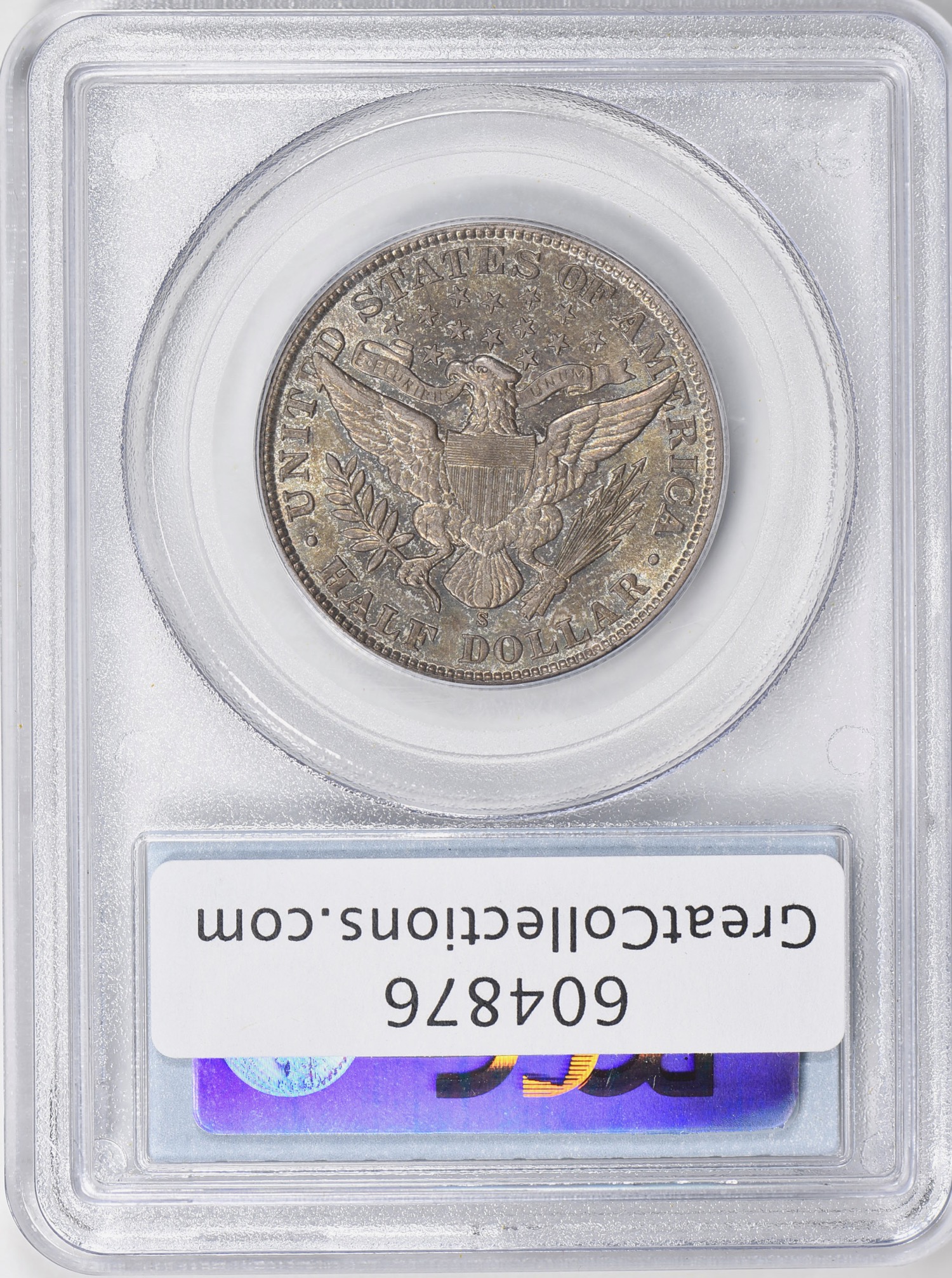
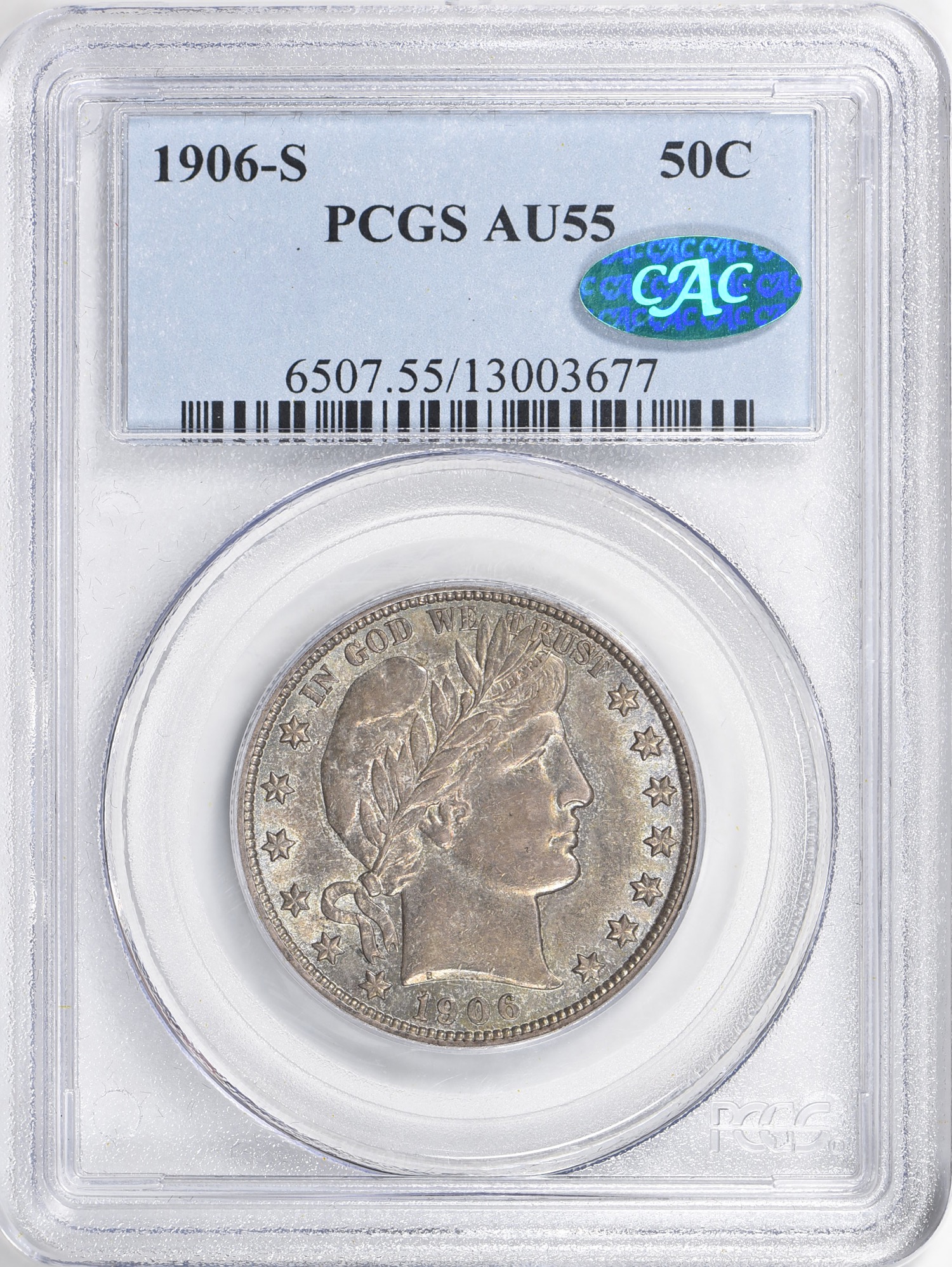
In 1906, 1907 and 1908, Barber half dollars were struck at all four mints. A 1906, 1907 or 1908 year set with four dates may be an excellent starting point. A collector who changes his or her mind about seeking to complete a whole set of Barber halves may enjoy collecting representatives of all four mints. Such a group of four would be more fun to acquire than a single Barber half for a type set.
Barber halves are all of the same design type. There are no subtypes. The only famous variety is the 1892 ‘Micro O,’ which is ignored by most collectors. Presumably, a mintmark punch that was intended for quarter dies was used on the reverse die for a half dollar, and thus the mintmark is a little too small on 1892-‘Micro O’ halves. This is not a matter of tremendous importance, in my view. The 1892-‘Micro O’ is not sensational. It is a curious die variety.
Ignoring the 1892-‘Micro O,’ there are seventy-three dates (including U.S. Mint locations) in the series of Barber Half Dollars. Some are condition rarities in grades above VF-20.

Common Date Barber Half Dollars
‘Common date’ Barber half dollars tend to be much scarcer than the ‘common dates’ in other series of U.S. coins that were minted late in the 19th century or during the first half of the 20th century. Indeed, the least scarce Barber Halves are much scarcer than the least scarce Barber quarters, Barber Dimes, Liberty Nickels, Indian cents, Liberty Seated quarters, Standing Liberty quarters, Walking Liberty half dollars, Morgan silver dollars, and Indian Head quarter eagles.
Quite a few Philadelphia Mint Barber halves are ‘common dates,’ 1897 to 1902, 1906 to 1909, 1911 and 1912. All the Denver Mint dates are ‘common dates’ or nearly so. As there are thousands of Barber halves that have never been submitted for certification, do not qualify for numerical grades or have been submitted multiple times, it is very difficult to know for sure which dates are the least scarce. It is almost impossible to fairly estimate the number of survivors in total for each date.
While many of the ‘better dates’ were minted in San Francisco, the 1915-S is a ‘common date.’ The 1903-S, 1905-S, 1906-S, 1910-S, 1912-S and 1913-S are not among the most common dates, yet are common enough to be accurately termed ‘common dates.’ Generally, a set of Barber halves that grade below VF-20 is very easy to assemble.
Average quality, uncirculated rolls of Barber halves were saved as money or for their silver content, especially by people who were nervous about the well being of bank accounts in general. More so than in the present, many U.S. citizens during the period from 1892 to 1915 wished to maintain significant portions of their savings in silver coins. Also, it was common then for banks to keep rolls of silver coins in their vaults, sometimes for decades.
Barber halves kept as personal savings or bank reserves were not always stored properly or handled with care. Some have serious problems in the present and others just have distracting contact marks.
Even a substantial percentage of certified MS-60 to MS-63 grade Barber halves have been cleaned to a medium extent, blatantly dipped, full of hairlines, battered with contact marks and scratches, or notably annoying in other ways. I prefer naturally toned, XF-40 to AU-55 grade Barber halves to most of those that have been certified in the MS-60 to MS-63 grade range.
Barber Half Dollar Premiums and Public Sales
In circulated grades, the 1906-O, 1907-O and 1908-O are the most common New Orleans Mint coins, and are not expensive. The 1903-O is relatively common, too. Generally, Barber halves from 1906 to 1908 are not hard to find, though many trade privately or at coin shows, rather than in public sales.
Back on Oct. 2, 2016, David Lawrence Rare Coins publicly sold a CAC approved XF-45 grade 1906 half for $252. If this same coin was sold in 2022, it would probably have realized between $225 and $325, perhaps around $280.
Back in May 2018, GreatCollections sold a CAC approved XF-40 grade 1906-D for $183.38. Actually, this is the only 1906-D that is CAC approved as XF-40. On May 7, 2022, the CPG retail price estimate for it was $304. On April 5, 2020, GreatCollections sold a CAC approved AU-58 1906-D for $421.88.
It is particularly hard to find a 1906-O that has been CAC approved in the XF-40 to AU-55 range. As of May 12, 2022, CAC has approved two as XF-40, one as XF-45, one as AU-50, zero as AU-53, and one as AU-55. Over the course of my life, I have seen additional, XF-40 to AU-55 grade 1906-O halves that I believe would qualify for CAC approval if submitted. CAC population numbers might give the impression to some collectors that finding nice XF-40 to AU-55 ‘common date Barber half dollars is more difficult than it really is in actuality. In general, the percentage of surviving, circulated classic U.S. coins that are submitted to CAC is much lower than the percentage of surviving uncirculated coins.
On Feb. 2, 2022, Stack’s Bowers sold a non-CAC, NGC graded XF-40 1906-O for $240. On Feb. 11, 2020, Heritage sold a CAC approved AU-58 1906-O for $960.
Back in August 2018, GreatCollections sold a CAC approved AU-55 grade 1906-S for $461.25. On July 14, 2019, Heritage auctioned a CAC approved AU-58 grade 1906-S for $1080. Rather than pay so much, a collector could wait for a CAC approved XF-40 or -45 grade 1906-S to become available, perhaps for a price in the $300 to $400 range.
In the XF-40 to AU-55 range, CAC approved Barber halves from the year 1907 are similar in rarity to those from 1906. On April 7, 2020, Heritage sold a CAC approved AU-53 1907 for $267.60. On Nov. 24, 2019, GreatCollections sold a CAC approved, NGC graded AU-55 1907 half for $295.88. As of May 12, the current CPG-CAC retail price estimates for these coins are $445 and $515, respectively. These CPG value estimates were notably increased during the month of April 2022.
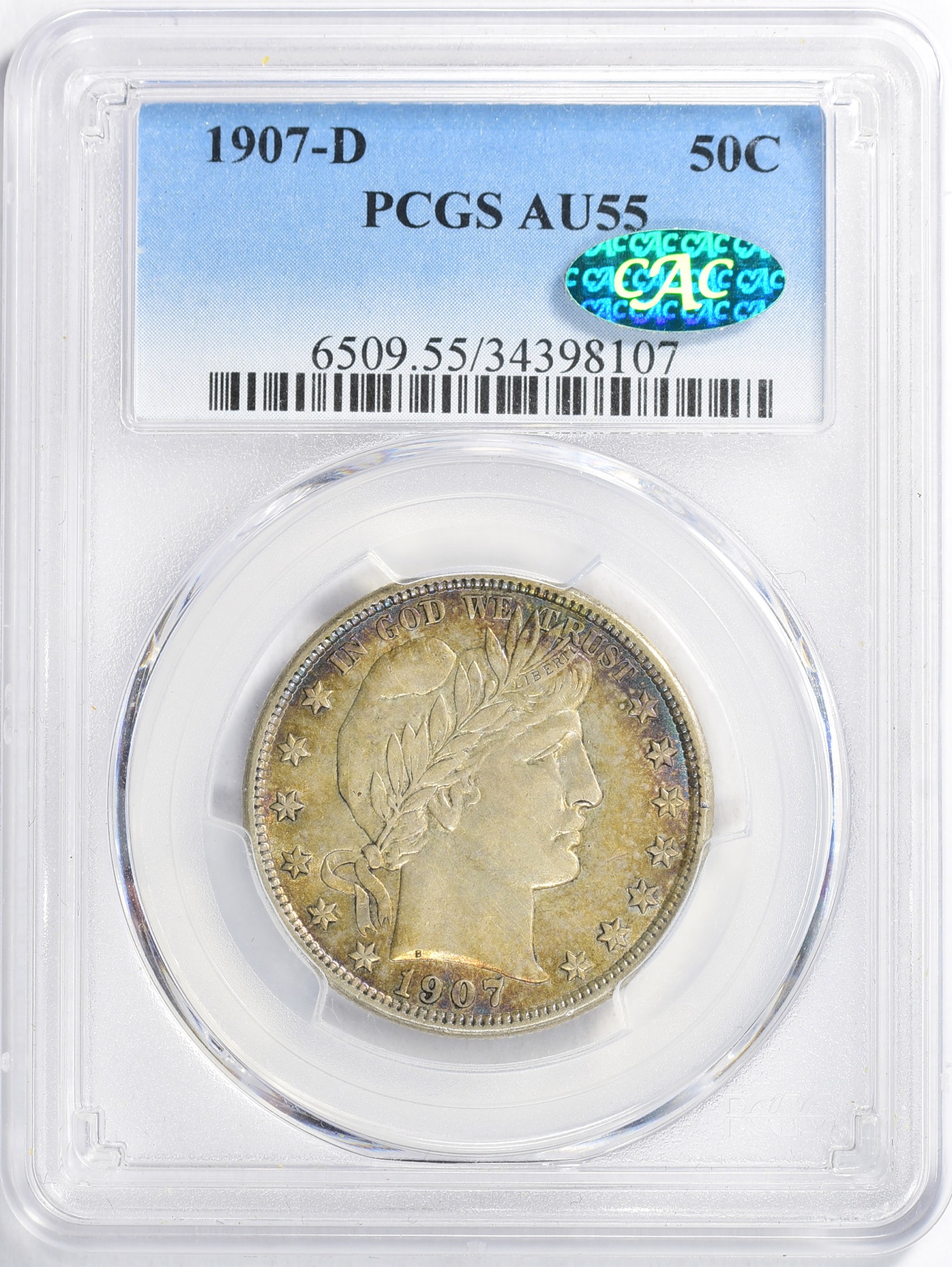
The 1907-D is certainly one of the least difficult Denver Mint issues to find in XF to AU grades. On Nov. 29, 2020, GreatCollections sold a CAC approved AU-55 grade 1907-D for $351.02.
On May 8, 2018, Heritage sold a CAC approved AU-55 grade 1907-O for $409.20. On Sept. 12, 2021, GreatCollections sold a CAC approved AU-58 grade 1907-O for $646.88.
The CPG-CAC retail price estimate for an XF-40 grade 1907-S is $507. In the XF-40 to AU-55 grade range, the CAC population report lists eight 1907-S halves, as of May 12, 2022. In July 2019, Scotsman auctioned a CAC approved AU-58 grade 1907-S for $2185.

Show off Your Collection in the CAC Registry!
Have CAC coins of your own? If so, check out the CAC Registry–the free online platform to track your coin inventory, showcase your coins by building public sets, and compete with like-minded collectors!
“Better Date” Barber Half Dollars
In some cases, it is easier to find a CAC approved ‘better date’ (relatively scarce) Barber half in XF-40 grade than a ‘common date’ because dealers have more to gain financially by incurring the costs of submitting the ‘better dates’ to CAC. The submission and shipping costs amount to a lower percentage of the value of each respective ‘better date.’ As an individual collector learns more about Barber halves, he or she may wish to submit some coins to CAC.
It is probably beneficial to view many Barber halves before acquiring the most scarce dates, which are considerably more expensive than the others. In XF-40 to AU-55 grades, it is hard to be sure which dates are the scarcest as a coin that is relatively scarce in MS-64 grade might not be relatively scarce in XF-40 grade. It is clear, though, that the 1904-S is the key to the series of Barber half dollars.
The 1904-S and the 1896-O are the only two dates that are estimated to retail for more than $2000 each in XF-40 grade. Although an XF-40 grade 1892–‘Micro O’ is worth far more than $2000, most collectors will just buy an 1892 with a normal ‘O.’ The ‘Micro O’ is an anomaly.
The CPG-CAC retail price estimate for an XF-40 grade, normal 1892-O was $842 on May 12, 2022, less than one twentieth as much as the CPG-CAC retail price estimate for an XF-40 grade 1892–‘Micro O,’ $19,400, a large premium for a mildly apparent variety. On May 9, 2021, David Lawrence Rare Coins sold a CAC approved AU-53 grade, normal 1892-O for $905.
It may require patience to find an appealing 1904-S in XF-40 to AU-55 grade, and there is often much competition among collectors for 1904-S halves that emerge. In March 2018, Heritage sold a CAC approved XF-40 grade 1904-S half for $3000. In January 2016, Heritage sold a different CAC approved XF-40 grade 1904-S half for $3290.
In January 2017, the regular Greysheet Bid value for an XF-40 1904-S was $3200. By November 2020, Greysheet Bid had fallen to $1675, a drop of nearly 50%. The logic behind this is not evident to me. It is true that a non-CAC, PCGS graded XF-40 1904-S was auctioned for $1680 in August 2018. This could have been an outlier or a problematic coin. Also, Heritage auctioned a CAC approved XF-40 grade 1904-S for $3000 on March 30, 2018.
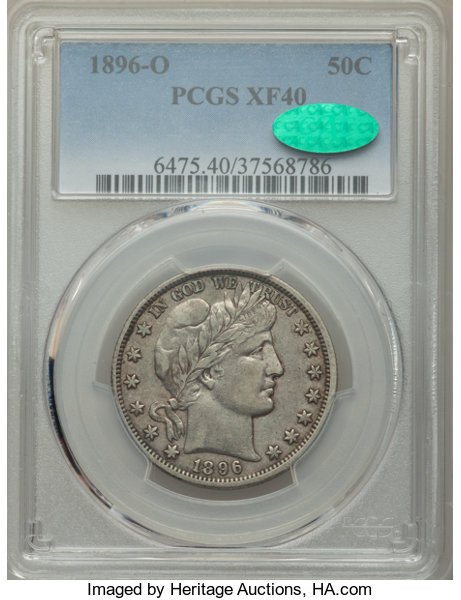
As of May 12, 2022, the CPG-CAC retail estimate for an XF-40 grade 1904-S was $2510, too low. A collector may have to spend as much as $3500 for an XF grade 1904-S half.
In XF to AU grades, the 1896-O half dollar is almost as scarce as the 1904-S. On January 9, 2020, Heritage auctioned a CAC approved XF-40 grade 1896-O for $2640.
1897 to 1901 Barber Half Dollars
There is no agreement among Barber half enthusiasts as to whether the 1897-O and 1897-S are scarcer overall than the 1901-O and 1901-S. All four are condition rarities in grades above VF-20 or so.
In December 2019, Heritage sold a CAC approved XF-40 grade 1897-O for $1440, perhaps a very good deal. As of May 12, 2022, CAC has approved three 1897-O halves as XF-40, one as XF-45, one as AU-50, zero as AU-53 and zero as AU-55. In this grade range, the 1897-S is not quite as scarce.
The CAC population report lists three 1897-S halves as AU-55 and six as XF-40. Are those six really six different coins? Not one of them has recently sold, publicly. Have any CAC approved AU-55 grade 1897-S halves been offered since 2010?
Heritage sold the same CAC approved AU-58 grade 1897-S half for $3900 in 2017 and earlier for $4230 in 2015. I find that one to be more appealing than another CAC approved AU-58 grade 1897-S half that Heritage sold for more, $5405 in August 2016 and $14,950 in May 2012!
Even a non-CAC 1901-O that has been PCGS or NGC graded in the range of XF-40 to AU-55 may be hard to find. In January 2018, Heritage auctioned a PCGS graded AU-53 1901-O for $2400.
The CAC pop report lists two 1901-O halves as XF-40, four as XF-45, one as AU-50, zero as AU-53 and one as AU-55. I do not recollect seeing any of these. It may be particularly difficult to find an appealing XF to AU grade 1901-O.
There are many Barber halves for which a small number have been CAC approved in grades ranging from XF-40 to AU-55. Indeed, a CAC-only set in this grade range would be an exciting goal, even if some VF-30, VF-35 or AU-58 grade coins are admitted into it.
One of the great aspects of collecting Barber halves is that sets can be truly completed in most grade ranges at costs that are certainly reasonable in the context of classic U.S. silver coins. Also, it is challenging to pursue relatively original XF to AU Barber halves and exciting to find them.
Images are copyrighted by DLRC (www.davidlawrence.com), www.GreatCollections.com, or Heritage Auctions (www.ha.com).
Copyright © 2022 Greg Reynolds
About the Author
Greg is a professional numismatist and researcher, having written more than 775 articles published in ten different publications relating to coins, patterns, and medals. He has won awards for analyses, interpretation of rarity, historical research, and critiques. In 2002 and again in 2023, Reynolds was the sole winner of the Numismatic Literary Guild (NLG) award for “Best All-Around Portfolio”.
Greg has carefully examined thousands of truly rare and conditionally rare classic U.S. coins, including a majority of the most famous rarities. He is also an expert in British coins. He is available for private consultations.
Email: Insightful10@gmail.com
